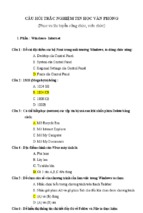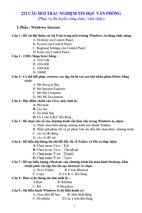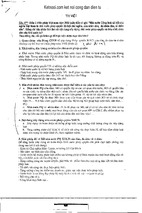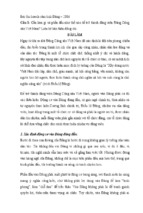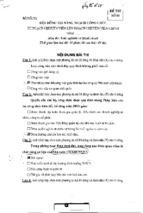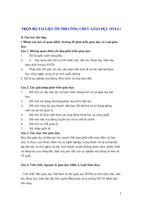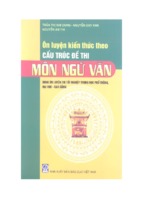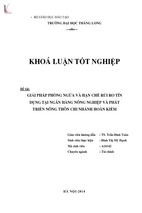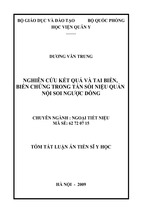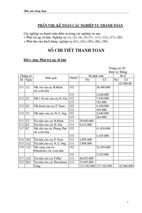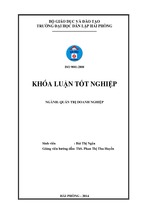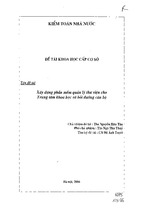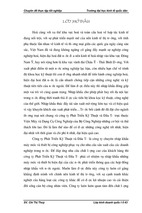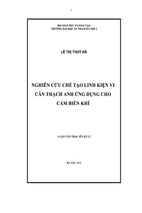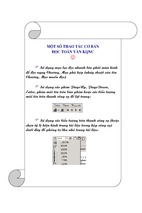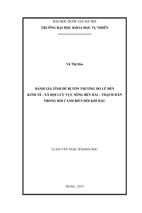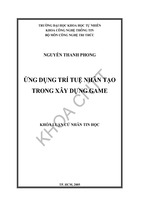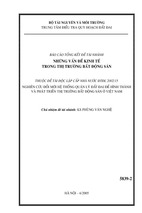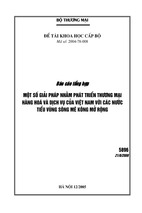Thiên Cảnh
Page 1
10/25/2008
Designing parametric
spur gears with Catia V5
The powerful CAD system Catia
version 5 has no
built-in tool for designing gears.
When you are making
a realistic design, you may need a
template spur gear.
Since the geometry of a spur gear is controlled by a few parameters,
we can design a generic gear controlled by the following parameters:
The pressure angle a.
The modulus m.
The number of teeth Z.
This tutorial shows how to make a basic gear that you can freely re -use in your
assemblies.
Thiên Cảnh
Page 2
10/25/2008
1. Gears theory and standards
1.1 Table of useful parameters and formulas
Here is a table containing the parameters and formulas used later in this t utorial:
The table is given first so that you can use it for further copy/paste
operations.
All the units are defined in the metric system.
This figure shows the a, ra, rb, rf, rp parameters defined in the table:
#ParameterType or unit
1 a
angular
degree
Formula
20deg
Description
Name in French
Pressure angle:
technologic constant
(10deg ≤ a ≤ 20deg)
Angle de pression.
Thiên Cảnh
Page 3
10/25/2008
2 m
millimeter —
Modulus.
3 Z
integer
Number of teeth (5 ≤ Z
Nombre de dents.
≤ 200).
—
Module.
millimeter m * π
Pas de la denture sur
Pitch of the teeth
une
on a straight generative
crémaillère génératrice
rack.
rectiligne.
millimeter p / 2
Circular tooth
thickness,
measured on the pitch
circle.
6 ha
millimeter m
Addendum = height of
a tooth
Saillie d'une dent.
above the pitch circle.
7 hf
if
m
> 1.25
hf = m
millimeter
* 1.25
else hf = m
* 1.4
Dedendum = depth of a
tooth below
the pitch circle.
Proportionnally greater
for a small modulus (≤
1.25 mm).
Creux d'une dent. Plus
grand
en proportion pour un
petit module (≤ 1.25
mm).
8 rp
millimeter m * Z / 2
Radius of the pitch
circle.
Rayon du cercle
primitif.
9 ra
millimeter rp + ha
Radius of the outer
circle.
Rayon du cercle de
tête.
10 rf
millimeter rp - hf
Radius of the root
circle.
Rayon du cercle de
fond.
11 rb
millimeter rp * cos( a )
Radius of the base
circle.
Rayon du cercle de
base.
12 rc
millimeter m * 0.38
Radius of the root
concave corner.
(m * 0.38) is a
normative formula.
Congé de
raccordement à la
racine
d'une dent. (m * 0.38)
vient de la norme.
13 t
floating
point
number
Sweep parameter
of the involute curve.
Paramètre de balayage
de la courbe en
développante.
14 yd
Y coordinate
rb * ( sin(t *
of the involute tooth
π) millimeter
profile,
cos(t * π) * t
generated by the t
*π)
parameter.
4 p
5 e
0≤t≤1
Epaisseur d'une dent
mesurée sur le cercle
primitif.
Coordonnée Y du
profil de dent
en développante de
cercle,
généré par le
Thiên Cảnh
Page 4
10/25/2008
paramètre t.
15 zd
rb * ( cos(t
Z coordinate
* π) +
millimeter
of the involute tooth
sin(t * π) * t
profile.
*π)
16 ro
rb * a * π /
millimeter
180deg
17 c
angular
degree
Angle of the point of
sqrt( 1 / cos(
the involute
a )2 - 1 ) /
that intersects the pitch
PI * 180deg
circle.
Angle du point de la
développante à
l'intersection avec le
cercle primitif
angular
degree
Rotation angle used for
atan( yd(c)
making a
/ zd(c) ) +
gear symetric to the ZX
90deg / Z
plane
Angle de rotation pour
obtenir un
roue symétrique par
rapport au plan ZX
18 phi
Radius of the
osculating circle of
the involute curve, on
the pitch circle.
Coordonnée Z du
profil de dent
en développante de
cercle.
Rayon du cercle
osculateur à la courbe
en développante, sur le
cercle primitif.
1.2 Notes about the formulas (in French)
Formule N°11: explication de l'équation
rb = rp * cos( a ) :
La crémaillère de taillage est tangente au cercle primitif.
Au point de contact, a définit l'angle de pression de la ligne d'action.
La ligne d'action est tangente au cerce de base.
On a donc un triangle rectangle à résoudre.
Formule N°12:
Entre le cercle de pied et les flancs des dents,
prévoir un petit congé de raccordement pour atténuer l'usure en fatigue.
Formules N°14 et N°15: explication de
zd = rb * cos( t ) + rb * t * sin( t ) :
La développante est tracée sur le plan YZ, qui correspond à la vue de face
dans Catia.
Le premier terme rb * cos( t ) correspond à une rotation suivant le cercle
de base.
Le second terme rb * t * sin( t ) correspond au déroulement de la
développante.
Cette expression rappelle que le rayon de coubure de la développante vaut rb
* t.
Formule N°16:
Thiên Cảnh
Page 5
10/25/2008
Pour simplifier le dessin d'un engrenage, on peut éventuellement
remplacer la développante de cercle par un arc de cercle.
A good approximation of a curve
at a given point is the osculating
circle.
Une bonne approximation d'une courbe
en un point donné est le cercle osculateur.
The osculating circle of a curve at a
point
shares with the curve at that point:
Le cercle osculateur à une courbe en un
point
partage avec la courbe en ce point:
A common tangent line
(continuity of the 1 stderivative).
A common radius of curvature
(continuity of the 2 nd
derivative).
Une même tangente
(continuité au 1 erdegré).
Un même rayon de courbure
(continuité au 2 nd degré).
Cercle osculateur à la courbe développante au niveau du diamètre primitif:
o L'angle de la dévelopante est égal à l'angle de pression a.
o Le rayon du cercle osculateur est donc: ro = rb * a * π / 180 .
Formule N°17:
En réalité, la développante est déphasée par rapport à la figure ci dessus.
Pour exprimer ce déphasage, on calcule le paramètre angulair e c au point où
la développante coupe le cercle primitif.
On a alors:
o
o
o
o
zd(c)2 + yd(c) 2 = rp2
rb2 * ( 1 + c 2 ) = rp 2
cos(a) 2 * ( 1 + c 2 ) = 1
c2 = 1/cos(a) 2 - 1
Thiên Cảnh
Page 6
10/25/2008
2. Start and configure the generative shape
design workshop
The part design workshop is not sufficient for designing parametric curves.
So, we switch to the generative shape design workshop:
Next, we configure the environment for showing parameters and formulas:
We set the 2 highlighted check boxes:
Thiên Cảnh
Page 7
10/25/2008
Now the tree of your part should look like this:
3 Enter the parameters and formulas
3.1 Define the primary generation parameters
Switch to the Generative Shape Design workshop and click on the
button:
Then you can create the gear generation param eters:
1. Select the unit (integer, real, length, angle, …).
2. Press the create parameter button.
3. Enter the parameter's name.
4. Set the initial value, used only if the parameter has a fixed value.
f(x)
Thiên Cảnh
Page 8
10/25/2008
Now your tree should look like this:
3.2 Define dependent parameters
Most of the geometric parameters are related to a, m, and Z.
You don't need to assign them a value, because Catia can co mpute them for
you.
So, instead of filling the initial value, you can press the add formula button.
Thiên Cảnh
Page 9
Then you can edit the formula:
10/25/2008
Thiên Cảnh
Page 10
10/25/2008
3.3 Check the primary and computed parameters
Set the following option in order to display the values and formulas of each
parameter:
Now your tree should display the following parameters and their formulas:
Thiên Cảnh
Page 11
10/25/2008
3.4 Parametric laws of the involute curve
Up to now, we have defined formulas for computi ng parameters.
Now we need to define the formulas defining the {Y,Z} cartesian position of the points on
the involute curve of a tooth.
We could as well define a set of parameters Y0, Z0, Y1, Z1, … for the coordinates of the
involute's points.
However, Catia provides a more convenient tool for doing that: the parametric laws.
In order to create a parametric law:
click on the fog button:
Enter the formulas #14 and #15 of the 2 laws used for the
of the involute curve:
o
o
yd
PI
zd
PI
Y
and Z coordinates
= rb * ( sin( t * PI * 1rad ) - cos( t * PI * 1rad ) * t *
)
= rb * ( cos( t * PI * 1rad ) + sin( t * PI * 1rad ) * t *
)
Thiên Cảnh
Page 12
10/25/2008
Notes about the formula editor of Catia:
The trigonometric functions expect angles, not nu mbers,
so we must use angular constants like 1rad or 1deg.
PI stands for the π number.
4. Create a geometric body and start inserting
geometric elements
In Catia, the PartBody is intended for mechanical surfaces.
For geometric constructions, you need to work in a geometric body:
Thiên Cảnh
Page 13
Create it with the
Insert / Open Body
10/25/2008
top menu:
Then, you can use the buttons on the right toolbar for inserting different
geometric elements.
Catia assigns a default name to each geometric element, but you can rename
it with a contextual dialog
Thiên Cảnh
Page 14
opened with the
10/25/2008
right button / properties
menu of the mouse:
5. Make the geometric profile of the first tooth
The following steps explain how to design a single tooth.
The whole gear is a circular repetition of that first tooth.
5.1 Define the parameters, constants and formulas
Already done in the section related to parameters and formulas.
5.2 Insert a set of 5 constructive points and connect them with a
spline
The position of each point is defined by the
yd(t)
and zd(t) parametric laws:
Thiên Cảnh
Page 15
10/25/2008
Define 5 points on the YZ plane.
In order to apply the involute formulas, edit the Y and Z coordinate of each
point
and enter the values of the parameter from t = 0 to t = 0.4
(most gears do not use the involute spiral beyond 0.4)
Thiên Cảnh
Page 16
For example, for the
0.2:
Y
10/25/2008
coordinate of the involute's point corresponding to
t =
Thiên Cảnh
Page 17
10/25/2008
Make a spline curve connecting the 5 constructive points:
5.4 Extrapolate the spline toward the center of the gear
Why do we need an extrapolation ?
The involute curve ends on the base circle of radius
* 0.94 .
rb = rp * cos(20) ≈ rp
Thiên Cảnh
Page 18
10/25/2008
When Z < 42, the root circle is smaller than the base circle. For example,
when Z = 25:
rf = rp - hf = rp - 1.25 * m = rp * (1 - 2.5 / Z) = rp * 0.9 .
So the involute curve must be extrapolated for joining the root circle.
Extrapolate the spline:
Start from the 1 st involute point.
The length to extrapolate is empirically defined by the formula
f(x) = 2 * m :
Thiên Cảnh
Page 19
10/25/2008
5.5 Rotate the involute curve for the symmetry relative to the
plane
Why do we need a rotation ?
On the extrapolated involute curve designed in the
RED
system …
Y, Z
ZX
coordinate
the contact point on the pitch circle has an unconvenient position.
It is more convenient to draw a tooth that is symmetric on the ZX plane,
because it makes it easier to control the angular position of a gear in a mechanism :
LIME
On the rotated involute curve …
the two contact points of the tooth …
CYAN
that are located on the pitch circle at
MAGENTA are symmetric relative to the
ZX
± 90deg / Z
…
plane.
The colors above correspond to the following geometric elements:
Thiên Cảnh
Page 20
10/25/2008
For computing the rotation angle, we need first to compute the involute
parameter or the pitch circle (formula #17):
- Xem thêm -

